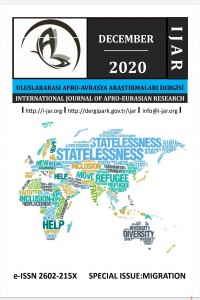Öz
Göçün insanlık tarihi kadar eski bir olgu olduğu bilinmektedir. Modern öncesi dönemlerde istilalar, fetihler ve savaşlar bazı halkların yerinden edilmesini, bazılarının ise yeni yerleşimler edinmesini beraberinde getirmiştir. Göçün arka planında güvenlik ve yeni toprakların zenginliği önemli bir yer tutarken, diğer taraftan modern öncesi dönemde kölelik, modern dönemde ise çalıştırılacak insan gücü göçe sebep olan diğer hususlardır. 2. Dünya Savaşı’ndan sonra Sosyalist Federal Yugoslavya Cumhuriyeti’nden (SFYC) Avrupa’nın sanayileşmiş ülkelerine gerçekleşen işçi göçleri, bu kapsamda emek göçü olarak değerlendirilmektedir. Göç alan ülkeler açısından hızlı kalkınma, göç veren ülkeler boyutundan ise göçmen transferleri, göçün ekonomik kalkınma ile olan ilişkisini önemli bir konu haline getirmiştir. Bu çalışma, Yugoslavya’dan Avrupa’ya gerçekleşen emek göçünün ekonomik kalkınma ile ilişkisini, göç alan ve göç veren ülkeler açısından olumlu, olumsuz sonuçlarını ele almaktadır.
Anahtar Kelimeler
Destekleyen Kurum
TUİÇ - Uluslararası İlişkiler Çalışmaları Derneği
Kaynakça
- Aktaş, Munise Tuba. 2015. “Ücret Odakli Uluslararası İşgücü Hareketliliğinin İşgücü Piyasalarına Etkileri.” TESAM Akademi Dergisi 2(2):197–219.
- Baletic, Z. 1982. “International Migration in Modern Economic Development: With Special Reference to Yugoslavia.” International Migration Review 16(4):736–56.
- Baučić, Ivo. 1976. “Some Economic Consequences of Yugoslav External Migrations.” Les Travailleurs Étrangers En Europe Occidentale 87–104.
- Bonifazi, Corrado, and Marija Mamolo. 2004. “Past and Current Trends of Balkan Migrations.” Espace-Populations-Societes (3):519–31.
- Brunnbauer, Ulf. 2016. “Migration and Economic Development in Socialist Yugoslavia.” Ostblog - Hypotheses. Retrieved November 30, 2020 (https://ostblog.hypotheses.org/728).
- Brunnbauer, Ulf. 2019. “Yugoslav Gastarbeiter and the Ambivalence of Socialism: Framing Out-Migration as a Social Critique.” Journal of Migration History 5(3):413–37.
- Castles, Stephen. 2009. “Development and Migration – Migration and Development: What Comes First?” Social Science Research Council (2):1–25.
- Četković, Predrag. 2015. “The Role of Banks in the Economic Development in the Former SFR Yugoslavia.” The Wiiw Balkan Observatory Working Papers 114(February):1–24.
- Chiswick, R. Barry. 1999. “Are Immigrants Favorably Self-Selected ?” The American Economic Review 89(2):181–85.
- Cortina, Jeronimo, and Ochoa-Reza Enrique. 2013. New Perspectives on International Migration and Development.
- Fassmann, Heinz, and Rainer Munz. 1994. “European East-West Migration, 1945-1992.” Center for Migration Studies of New York 28(3):520–38.
- Gerold-Scheepers, J. F. A., and W. M. J. van Binsbergen. 1978. “Marxist and Non-Marxist Approaches to Migration in Tropical Africa.” African Perspectives 21–35.
- De Haas, Hein. 2010. “Migration and Development: A Theoretical Perspective.” International Migration Review 44(1):227–64.
- Hagen-Zanker, Jessica. 2011. “Why Do People Migrate? A Review of the Theoretical Literature.” SSRN Electronic Journal.
- Halpern, Joel M. 2011. “Some Perspectives on Balkan Migration Patterns (with Particular Reference to Yugoslavia).” Migration and Urbanization: Models and Adaptive Strategies (January):77–116.
- IOM History. 2020. “IOM History.” Retrieved November 30, 2020 (https://www.iom.int/iom-history).
- Kirisci, Kemal. 1995. “Post Second World War Immigration from Balkan Countries to Turkey.” Retrieved November 30, 2020 (https://pubmed.ncbi.nlm.nih.gov/12290934/).
- Kogan, Irena. 2002. Labour Market Inclusion of Immigrants in Austria and Sweden: The Significance of the Period of Migration and the Effect of Citizenship Acquisition.
- Kosinski, Leszek A. 1978. “Yugoslavia and International Migration.” Canadian Slavonic Papers 20(3):314–38.
- Lee, Everett S. 1966. “A Theory of Migration.” Demography 3(1):47–57.
- Lewis, W. A. 1954. “Economic Development with Unlimited Supplies of Labout.” Manchester School of Economic and Social Studies 22(2):139–91.
- Malacic, Janez. 1994. Labour Migration From Yugoslavia, European Migration in the Late Twentieth Century. edited by H. Fassmann and R. Münz. Edward Elgar Publishing Limited.
- Malačič, Janez. 1977. “Yugoslav Economists on Unemployment in Yugoslavia.” Eastern European Economics.
- Migration Data Portal. 2019a. “Migration Data Portal Migrant Stock.” Retrieved November 30, 2020 (https://migrationdataportal.org/?i=stock_abs_&t=2019).
- Migration Data Portal. 2019b. “Migration Data Portal Remittances.” Retrieved November 30, 2020 (https://migrationdataportal.org/?i=remit_re_excel&t=2019).
- OECD. 1975. “OECD Economic Surveys: Yugoslavia 1975.” Retrieved November 30, 2020 (https://www.oecd-ilibrary.org/economics/oecd-economic-surveys-yugoslavia-1975_eco_surveys-yucs-1975-en).
- S. Massey, Douglas, Joaquin Arango, Graeme Hugo, Ali Kouaouci, Adela Pellegrino, and Edward Taylor. 1993. “Theories of International Migration : A Review and Appraisal.” Population and Development Review 19(3):431–66.
- Sardon, Jean Paul. 2001. “Demographic Change in the Balkans since the End of the 1980s.” Population 13(2):49–70.
- Sirkeci, İbrahim, and Filiz Göktuna Yaylacı. 2019. “Küresel Hareketlilik Çağında Göç Kuramları ve Temel Kavramlar.” Pp. 15–39 in Transnational Press London.
- Stevanovic, R., and D. Breznik. 1991. “The Population of Yugoslavia, 1948-1991.” Yugoslav Survey 32(3):3–14.
- UN Press Release. 2006. “GENERAL ASSEMBLY.” Retrieved November 30, 2020 (https://www.un.org/press/en/2006/ga10494.doc.htm).
- de Wenden, Catherine Wihtol, and Solon Ardittis. 1994. The Politics of East-West Migration. Vol. 29. edited by S. Ardittis. London: Palgrave Macmillan UK.
- Willem, Molle, and Mourik Aad Van. 1988. “International Movemensrt of Labour under Conditions of Economic Integration: The Case of Western Europe.” Journal of Common Market Studies XXVI(3):317–42.
- World Bank. 2018a. “Net Official Development Assistance and Official Aid Received (Current US$) | Data.” Retrieved November 30, 2020 (https://data.worldbank.org/indicator/DT.ODA.ALLD.CD).
- World Bank. 2018b. “Record High Remittances Sent Globally in 2018.” Retrieved November 30, 2020 (https://www.worldbank.org/en/news/press-release/2019/04/08/record-high-remittances-sent-globally-in-2018).
Ayrıntılar
| Birincil Dil | Türkçe |
|---|---|
| Bölüm | Makaleler |
| Yazarlar | |
| Yayımlanma Tarihi | 30 Aralık 2020 |
| Yayımlandığı Sayı | Yıl 2020 Özel Sayı: Göç |
All rights reserved. International Journal of Afro-Eurasian Research (IJAR) is an International refereed journal and published biannually. Authors are responsible for the content and linguistic of their articles. Articles published here could not be used without referring to the Journal. The opinions in the articles published belong to the authors only and do not reflect those of International Journal of Afro-Eurasian Research.


